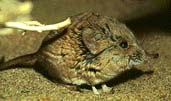

(elephant shrews)
Once considered a divergent Family of the Order Insectivora, elephant shrews are now placed in their own order, the Macroscelidea. Elephant shrews are a small group, represented by a single family, the Macroscelididae, including 4 genera and 19 living species. They are adapted for leaping, with hind limbs much longer than forelimbs. In one genus, Rhynchocyon, this is carried to an extreme with the toes on the hind foot being reduced to three in number. Elephant shrews have elongated snouts and large eyes and ears. They range from mouse-sized to the size of a squirrel or large rat. Some species are brightly colored.
Elephant shrews differ from members of the Insectivora in that they have complete auditory bullae, large jugals, complete zygomatic arches, and relatively small olfactory lobes of the brain.. The upper canine has two roots, like a premolar. Technically, elephant shrews can be recognized by a combination of their size, dental formula (1-3/3, 1/1, 4/4, 2/2-3 = 36-42), their quadrate molars, palate perforated by large gaps or fenestrae, and the limb characters mentioned above.
Elephant shrews are insectivorous and do most of their foraging at night. Most are solitary, although some species appear to live in small colonies. They are excellent hoppers, fleeing from predators with long bounds. They are found in a variety of habitats in northernmost Africa and south of the Sahara.
Family Elephantulus brachyrhynchus Family Elephantulus rufescens (East African Long-Eared Elephant Shrew) Family Rhynchocyon chrysopygus (Golden-Rumped Elephant Shrew)<<<<<<<>>>>>>> ARTIODACTYLA CARNIVORA CETACEA CHIROPTERA DASYUROMORPHIA DERMOPTERA DIDELPHIMORPHI DIPROTODONTIA HYRACOIDEA INSECTIVORA LAGOMORPHA MACROSCELIDEA MICROBIOTHERIA MONOTREMATA NOTORYCTEMORPHIA PAUCITUBERCULATA PERAMELEMORPHIA PERISSODACTYLA PHOLIDOTA PRIMATES PROBOSCIDEA RODENTIA SCANDENTIA SIRENIA TUBULIDENTATA XENARTHRA
Email: eradani7@aol.com